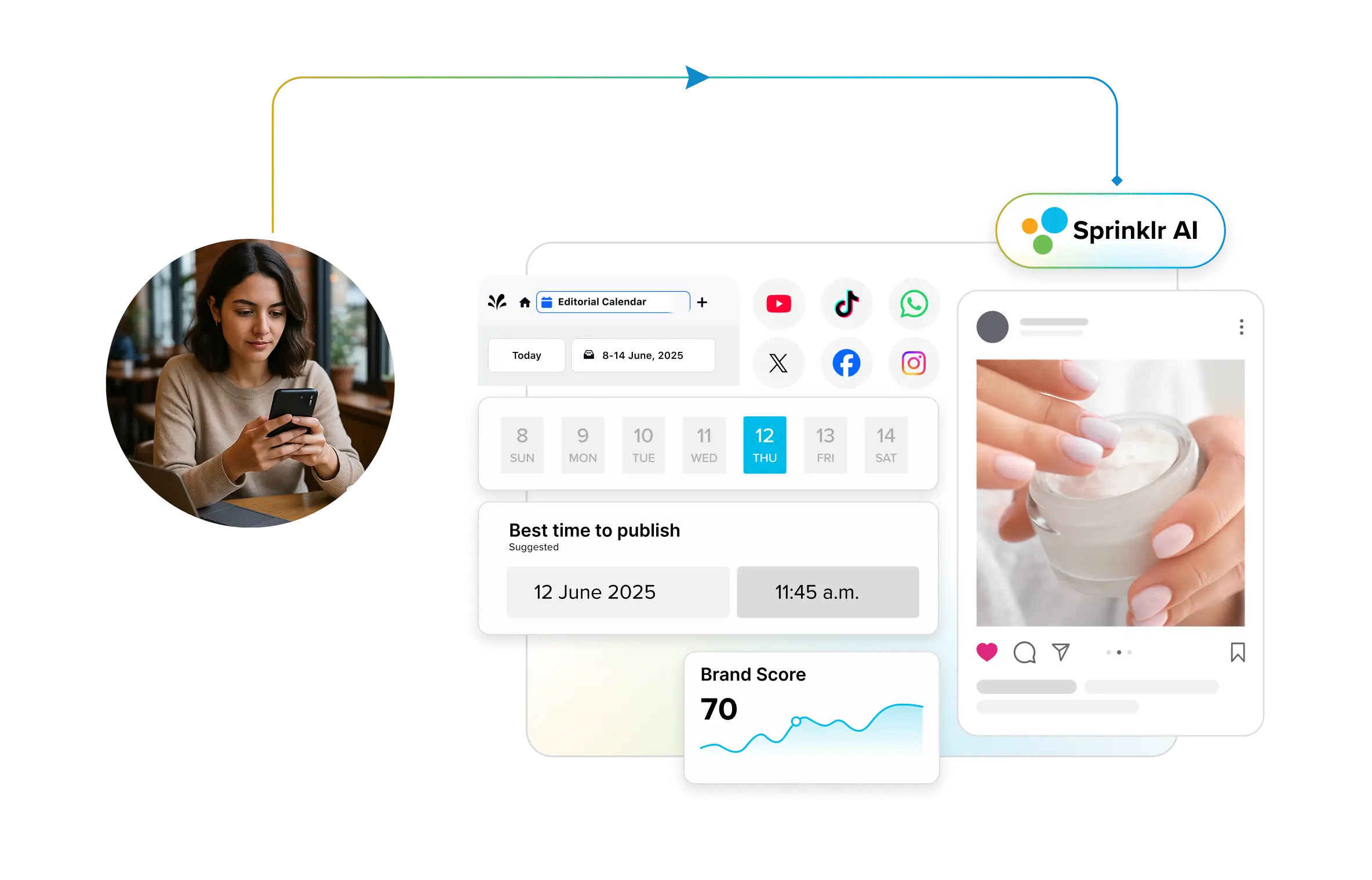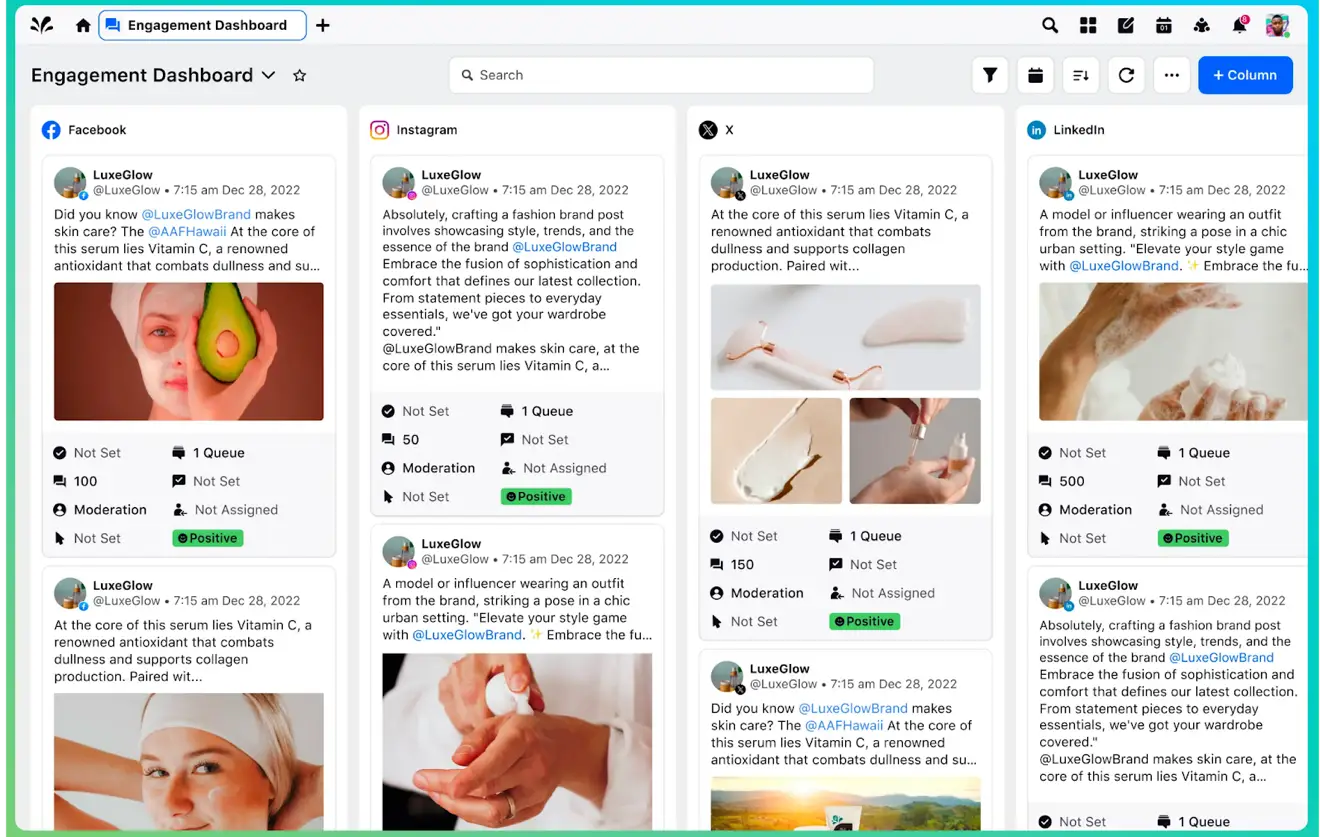The global leader in enterprise social media management
For over a decade, Sprinklr Social has helped the world’s biggest brands reimagine social media as a growth driver with a unified platform, industry-leading AI and enterprise-grade scale.

7 Social Media Lead Generation Strategies for 2025
In 2025, social media lead generation requires more than a boosted post or gated asset. Whether you're targeting enterprise buyers on LinkedIn or engaging B2C audiences on Instagram, generic ad campaigns no longer drive meaningful social media ROI—especially in regions with different platform behaviors, compliance requirements, and customer expectations.
A universal approach simply doesn’t scale across diverse markets. To succeed, brands need lead generation strategies that are localized, channel-specific, and tailored to specific audience segments.
In this article, we share seven proven social media lead generation strategies designed for today’s multi-market complexity. Backed by real-world brand outcomes, these strategies help marketing teams stay compliant, adapt to platform nuances, and accelerate lead conversion through smarter campaign design.
- What is lead generation on social media?
- Why social media is now essential for lead generation
- Top social media lead generation trends in 2025
- 7 lead generation strategies that work on social media
- Key social media lead generation challenges
- How top brands are driving lead generation through social media
- Future-proof your social media lead generation strategy
What is lead generation on social media?
Social media lead generation is the process of identifying and nurturing potential buyers through platforms like LinkedIn, X (formerly Twitter), Facebook, and Instagram. It is more than just collecting contact details; it’s about assessing buyer intent and aligning outreach to each stage of the customer journey.
For enterprise marketing teams, a lead isn’t just a form fill. It’s a data point within a broader intent signal framework: How closely does the lead match your Ideal Customer Profile (ICP)? Have they engaged with mid-funnel assets like a product webinar or an industry-specific guide? Is there behavioral data suggesting readiness to convert?
For example, a marketing director downloading a gated trend report via LinkedIn Lead Gen Forms is a far more valuable lead than a general engagement click on a boosted post. That’s why enterprise teams focus on not just capturing information, but scoring and segmenting leads across social touchpoints.
Why social media is now essential for lead generation
The modern buying journey begins on social media. While 75% of B2B buyers prefer a rep-free experience, B2C consumers heavily rely on influencer recommendations and peer feedback to validate products before purchase. Social media platforms serve as more than just brand awareness channels—they have become strategic touchpoints that shape perception, build trust, and drive the sales pipeline.
At the heart of this transformation is social selling, a strategy that empowers sales and marketing teams to connect directly with prospects by leveraging social platforms like LinkedIn, TikTok, and YouTube. Social selling enables brands to engage buyers with relevant content, demonstrate expertise, and nurture relationships throughout the sales cycle. Incorporating social selling into your GTM approach is essential to meet today’s buyer expectations and drive meaningful lead generation across both B2B and B2C markets.
Here are the key reasons why social media lead generation should be central to your marketing strategy:
- Expand Your Reach and Engagement: With billions of active users worldwide, social media platforms provide access to a diverse pool of potential customers. This reach boosts brand visibility, drives website traffic, and fosters meaningful interactions across industries.
- Target the right customers with precision: Audience targeting tools enable marketers to deliver relevant content and offers based on demographics, interests, and behavior—turning social followers into qualified leads.
- Optimize your marketing budget: Social media marketing is scalable and often more cost-effective than traditional channels. Real-time performance monitoring allows you to adjust campaigns for maximum ROI.
- Gain in-depth audience insights: Robust analytics tools provide data on user behavior and campaign success, helping refine strategies and improve lead generation outcomes.
- Nurture leads through relationship building: Social media fosters direct engagement, allowing businesses to answer questions, share valuable content, and build trust, transforming prospects into loyal customers.
Top social media lead generation trends in 2025
As platforms continue to innovate, businesses must adapt their strategies to align with their social media lead generation goals. Here are some social media lead generation trends in 2025:
1. Short-form videos: Brands are using bite-sized (30-60 second) videos to tease gated content, product use cases or event invites. These short videos drive interest before directing users to lead capture forms. These clips are distributed via LinkedIn and YouTube Shorts to warm up interest and drive traffic to high-conversion lead capture pages.
2. Conversational lead gen via messaging apps: Messenger, WhatsApp and Instagram DMs now support lead flows with pre-set questions and CTAs. This approach has gained traction in mobile-first regions and industries with longer sales cycles. Enterprises are integrating these flows into CRM systems for real-time sales follow-up.
3. Paid lead gen formats: Platforms like LinkedIn Lead Gen Forms, Meta Lead Ads, and TikTok Lead Ads are enabling seamless lead capture within the user experience, reducing drop-offs caused by external redirects. These formats are increasingly used in account-based marketing (ABM) campaigns to capture mid-funnel leads with high intent and verified firmographic data.
4. Zero-click lead gen experiences: Enterprise marketers are adopting “zero-click” strategies, where the entire lead journey—content consumption, interaction, and conversion—happens natively on the platform. LinkedIn Document Ads and carousels, for example, allow users to engage with high-value content without leaving the feed, reducing friction and boosting completion rates.
5. AI-powered audience segmentation: Enterprises are using AI-powered advanced audience modelling to segment users, personalize messaging at scale, and prioritize high-quality leads in real-time. These capabilities are transforming how social media campaigns are optimized, shifting the focus from volume to quality.
Also read: Social Media Lead Generation: 10 Proven Tactics
7 lead generation strategies that work on social media
Social media can drive qualified leads to operate at different scales. This is only possible when your strategy aligns directly with your audience’s intent, platform behavior and decision journey. Here are seven tried and tested lead-generation strategies:
1. Offer gated assets via paid social
Gated content like whitepapers, industry reports, or ROI calculators remain effective for capturing top and mid-funnel leads—especially when distributed via paid campaigns that target specific job roles and geographies.
What works:
- Share value-driven snippets on LinkedIn or X to build anticipation.
- Use tools like Meta Lead Ads or LinkedIn Lead Gen Forms to capture user info without redirecting them. LinkedIn Lead Gen Forms convert at an average rate of 13%, significantly higher than the 4.02% average landing page conversion rate.
- Offer hyper-relevant content. For example, “2025 Financial Benchmarking Report for Retail CX Leaders.”
2. Turn messaging apps into lead generation channels
With 2 billion people using WhatsApp in a month and Facebook Messenger reaching 947 million users, messaging apps are evolving into lead-gen channels. You can leverage these apps in mobile-first regions where chat is the default engagement format.
What works:
- Add click-to-message CTAs on Instagram and Facebook ads.
- Use chatbot flows to qualify leads instantly (e.g., budget, location, urgency).
- Integrate CRM handoff for high-intent responses.
For example, MindZero has turned Instagram DMs into a lead-gen channel. The South Carolina contrast therapy spa uses an AI-powered chatbot inside Instagram Direct Messages to qualify leads.
What’s smart is how it lowers the friction; potential clients can ask awkward or exploratory questions they might avoid in a human conversation. That transparency drives engagement and shortens the path to conversion.
3. Launch story-driven lead magnets on Instagram & TikTok
96% of video marketers think that video marketing increases user understanding of a product or service. Short-form video is dominating social, and enterprise marketers are adapting by pairing emotionally resonant stories with clear lead magnets. TikTok and Instagram Reels provide the ideal format for these fast-paced, attention-grabbing campaigns.
What works:
- TikTok and Instagram Reels with lead magnets like checklists or discount codes.
- LinkedIn video snippets + downloadable CTA (e.g., “Download our AI ROI calculator”).
- Add captions and hooks in the first 3 seconds.
Screenshot
For instance, Reel Paper, a sustainable toilet paper brand, uses Instagram Reels and TikTok to share quick, relatable stories. Each story ends with a clear CTA like “Want a better backup plan? Grab a free roll, just pay shipping.”
These emotionally resonant stories tie directly to a lead magnet (a free trial), helping Reel build a values-aligned email list at scale.
4. Leverage influencer-led content with embedded CTAs
Social proof drives action. Influencer-led content that fits your brand and audience can make your message feel more relatable and believable. Research suggests that 49% of users say they trust influencer recommendations while making purchase decisions.
What works:
- Partner with B2B micro-influencers to share gated content or webinars.
- For B2C, tie influencer-led reviews to discount CTAs or signup offers.
- Always disclose partnerships and measure ROI via UTM-tracked landing pages.
Grammarly partnered with productivity influencers on YouTube and Instagram to create short videos explaining how teams can streamline communication. Grammarly’s influencer marketing strategy helped them turn thought leadership into qualified trial signups, especially from startups and remote-first teams.
Read more: 7 Best Influencer Marketing Strategies to Try in 2025
5. Run contests or challenges with lead capture
Incentive-driven campaigns such as contests or UGC challenges provide dual benefits: higher engagement and conversion. Additionally, embedding lead forms, like LinkedIn Lead Gen Forms or TikTok Lead Gen Ads reduces the drop-off between the number of clicks and conversion.
What works:
- Pre-fill known fields using platform data to increase submission rates.
- Offer incentives like free consultations or limited-time trials.
- Integrate directly with your CRM or use social media management tools like Sprinklr to organize lead data across campaigns.
For example, Realtime Agency optimized a LinkedIn ad campaign using Sprinklr's Smart Bidding from the Sprinklr Marketing and Advertising suite. Automating the ad bidding process, they reduced the cost per lead by 19% and increased the lead volume by 37%.
6. Circle back to nurture unconverted leads
It often takes more than one interaction to convert a lead. That’s why many enterprise teams use social remarketing to follow up with people who watched your brand content, abandoned forms, or attended your marketing events.
What works:
- Create custom audiences from video viewers or form abandoners.
- Deliver educational content to build trust (e.g., “5 signs you’ve outgrown your CRM”).
- Combine the content with email blasts to guide leads down the funnel.
Conversion Stat: Nurtured leads produce, on average, a 20% increase in sales opportunities compared to non-nurtured leads. And when follow-ups are personalized after live events, engagement and conversions rise sharply.
7. Offer early access or demos
Social selling is most effective when internal teams become brand advocates. Equipping sales, product, and solutions engineering teams with ready-to-share gated content increases reach and drives warm leads into the pipeline.
What works:
- Activate your sales and subject matter experts to share POVs, product insights and case studies.
- Provide ready-to-use content in an internal hub.
- Track clicks and conversions using personal UTM links.
For example, BambooHR used LinkedIn Lead Gen Forms to offer early access to a new feature, streamlining the onboarding process. They activated their sales and product teams to share insights and case studies directly on LinkedIn. As a result, they got 53% higher submission rates compared to the forms on their website.
Pro Tip: Run smarter, more connected campaigns by centralizing your social strategy.
Use a unified social media management platform to manage everything from content planning and publishing to lead capture and performance analytics. Real-time dashboards keep your team aligned on what’s driving results. As a result, you iterate faster and cut through the chaos of scattered tools and disconnected data.

Want to see it in action? Book a demo and explore how connected campaigns can boost your ROI.
Key social media lead generation challenges
Scaling lead generation across global markets and teams comes with its challenges. Common barriers for generating leads on social media include:
- Fragmented customer journeys: Customer journeys are complex and spread across countless channels, devices, and locations. Brands face the challenge of connecting these interactions to create a seamless experience. When data is fragmented, messaging loses impact, personalization weakens, and customer loses trust. Sprinklr brings 30+ social and digital channels together into a unified view, enabling teams to understand the full journey and deliver consistent, meaningful engagement at every step.
- Low lead quality: With platform algorithms favoring paid content and engagement overreach, vanity metrics such as likes & impressions often mask declining conversion rates. Businesses require stronger intent signals and lead-scoring frameworks to differentiate between interest and actual purchase intent.
- Attribution complexity: Attribution complextity is a growing channel for multi-touch customer journeys. A single lead or purchase could be influenced by a LinkedIn campaign, a creator-led video, an email sequence, or a retargeting ad. Whether it’s a demo signup or an e-commerce checkout, pinpointing which touchpoint truly drove the conversion isn’t always clear. Without accurate marketing attribution, teams often make budget decisions based on their instinct rather than data. For enterprise brands managing long buying cycles or large-scale campaigns, adopting more sophisticated attribution models is essential to optimize spend and scale lead generation effectively.
- Channel silos: Enterprises often split campaign ownership between paid media teams, brand, and regional marketers. Without coordinated content calendars and audience targeting strategies, campaigns compete for attention instead of compounding impact.
- Lack of real-time insights: Delayed data and siloed analytics prevent enterprise marketers from reacting to high-intent signals at the moment. Without AI-driven insights or live performance dashboards, campaign optimization lags behind audience behavior. While these challenges are real, they’re not insurmountable. With the right strategies, teams can break down silos, boost lead quality and gain better insights.
Suggested read: 7 Examples of Social Media Strategies That Work Well
How top brands are driving lead generation through social media
So, how are top brands succeeding where others struggle? Let’s take a closer look at their winning tactics for generating leads on social media:
1. Alida - Customer Intelligence Platform
Alida adopted an ABM strategy, leveraging LinkedIn Sponsored Content and Lead Generation Forms to target senior decision-makers. They expanded reach using Matched Audiences and LinkedIn’s Account Targeting.
The outcome:
The campaign achieved a 5X increase in sales leads and a 122% boost in conversions, surpassing industry benchmarks.
2. Maserati - Luxury Automotive
Maserati reformatted its traditional TV ads to fit Instagram and Facebook Reels, focusing on high-impact, full-screen video content. By engaging visual effects, music and mobile-optimized storytelling, the brand connected with its target audience in a fresh, dynamic way.
The outcome:
The new Reels-focused creative led to a 25% increase in lead volume and a 20% reduction in cost per lead. This shows how platform-specific content can deliver more efficient, effective results.
3. Honda - Automotive
Honda unified customer care across digital and voice channels, using Sprinklr's Social Listening platform to deliver a seamless omnichannel experience for its new online car sales platform, Honda ON. Using customer engagement data, Honda met the needs of tech-savvy Millennials and Gen Z buyers.
The outcome:
As a result, Honda achieved more streamlined operations, improved customer engagement and a 360-degree care solution across social, email, chat and voice channels.
Read the complete case study How Honda Unified Customer Care in Online Car Sales
4. Everlane - Ethical Fashion
Everlane built its brand around "radical transparency," openly sharing details about its factories, production costs and sourcing practices. The company emphasizes sustainability by using lower-impact materials like organic cotton and recycled fibers, aiming to reduce virgin plastic usage.
The outcome:
This transparent approach has resonated with consumers seeking ethical options, contributing to Everlane's growth and recognition in the sustainable fashion market.
Future-proof your social media lead generation strategy
Generating quality leads on social media is no longer a matter of luck or volume—it’s about applying tested strategies with the right tools and insights. From experimenting with new formats to measuring every touchpoint, the path forward requires a unified, data-centric approach.
Enterprise brands need to move on from siloed campaigns to unified customer journeys. Test new formats. Measure everything. And invest in platforms like Sprinklr Social that bring data, content and execution together. Ready to take your social media lead generation to the next level? Book a demo with us today.
Frequently Asked Questions
LinkedIn is often cited as the best social media for B2B lead generation. However, the optimal choice depends on your target audience and your overall marketing objectives.
Enterprise brands can effectively track social media leads using a unified social media management platform like Sprinklr Social. It provides tools to capture, track and manage leads across all channels.
High-value content, such as educational resources (e.g., ebooks, webinars, case studies), resonates best with audiences and often generates significant leads. Emotionally engaging content like short-form videos, reels, testimonials and influencer collaborations also tend to drive more conversions.
Social media allows for more visual engagement, broader reach and organic lead generation. Email marketing is more direct and focused on nurturing leads. Ideally, a strong strategy integrates both practices.
Measure lead quality using metrics like engagement rate, conversion rate, lead source and ultimately, customer lifetime value (CLTV). A robust CRM system is essential for accurate lead qualification.










